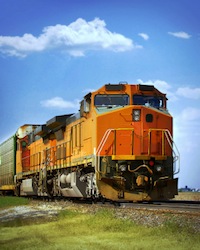Employment picks up in most states but federal cuts loom; rail, factory construction rise
Editor’s note: Construction Citizen is proud to partner with AGC America to bring you AGC Chief Economist Ken Simonson's Data DIGest. Check back each week to get Ken's expert analysis of what's happening in our industry.
 Click here to view February state employment tables.
Click here to view February state employment tables.
In February, seasonally adjusted nonfarm payroll employment increased from a year earlier in 49 states and the District of Columbia and dipped by 0.3% (800 jobs) in Wyoming, the Bureau of Labor Statistics (BLS) reported today. Seasonally adjusted construction employment climbed in 29 states and D.C., fell in 20 and was unchanged in Delaware. Alaska had the largest percentage increase (13.3%, 2,200 jobs), followed by Hawaii (8.0%, 2,300 jobs) and Texas (7.5%, 43,300 jobs). Texas added the most new construction jobs over the past 12 months, followed by California (35,800, 6.2%). Rhode Island lost the highest percentage (-10.4%, -1,700 jobs), followed by Arkansas (-9.6%, -4,700 jobs). Ohio lost the most jobs (-7,900, -4.3%), followed by Illinois (-7,500, -3.8%). From January to February, seasonally adjusted construction employment rose in 35 states, was static in three, and fell in 12 states and D.C. (BLS combines mining and logging with construction in D.C., Hawaii, Delaware and four other states to avoid disclosing data about industries with few employers).
President Obama on Tuesday signed the Consolidated and Further Continuing Appropriations Act, 2013, which appropriates funds for federal agencies through September 30. The law relaxes spending constraints that would have led to cancelation or delay of construction by some agencies but imposes a slightly greater percentage reduction in other programs than was required by the “sequestration” that it replaced. The Congressional Budget Office reported on Wednesday that caps on defense and nondefense “discretionary” budget authority have been reduced by $87-91 billion per year through 2021. Discretionary spending covers most federal dollars for construction (other than most Highway Trust Fund and Airport Improvement Program spending), as well as federal funding for education, medical, research and other programs that entail some nonfederal construction spending.
"All told, 2013 stands to be the [railroad] industry’s third year in a row of record capital spending—more than double the yearly outlays of $5.9 billion a decade ago,” the Wall Street Journal reported on Wednesday. BNSF “is investing $4.1 billion on a list that includes locomotives, freight cars, a giant terminal southwest of Kansas City and new track and equipment for its oil-related business in the Bakken shale region of North Dakota and Montana. Union Pacific Corp. is spending $3.6 billion on a giant terminal near Santa Teresa, N.M. It is designing a new $400 million-$500 million bridge over the Mississippi at Clinton, Iowa….It will double some track in Louisiana and Texas and expand rail yards there and in Arkansas…CSX Corp. will spend $2.3 billion partly to finish the first phase of a multiyear project, raising highway bridges, enlarging mountain tunnels and clearing some 40-odd obstacles to make enough space to accommodate double-decker containers all the way from the Midwest to the mid-Atlantic ports. Kansas City Southern Railway Co. will spend $515 million.”
Factory construction also appears to be picking up. “Ford will invest nearly $200 million and add jobs at its Cleveland engine plant,” the Journal reported on Wednesday. “Chrysler is putting $374 million into expanding transmission production in Indiana, and General Motors will spend $600 million to enlarge and upgrade an assembly plant in Kansas….The upturn in investment is a shift from mid-2012, when concerns about a year-end fiscal cliff of higher taxes as well as government spending cuts had many firms reining in ambitions. Some of those worries have since given way to a more optimistic mood. In the Business Roundtable’s first-quarter 2013 economic outlook survey, released this month, chief [executives] said they expected capital spending and sales to rise.” However, “Nigel Gault, chief U.S. economist at IHS Global Insight, said spending on equipment likely will remain brisk this year, while investment in structures, such as utilities’ power plants, won’t….A surge last year in spending on structures appears to have been mostly projects postponed during the recession. ‘Everything in structures was a big plus in 2012, but we don’t think it will be a big plus in 2013,’ he said.”
Average state personal income growth slowed to 3.5% in 2012 from 5.2% in 2011, the Bureau of Economic Analysis reported on Wednesday. “For the fifth time in the last six years North Dakota has had the fastest personal income growth of all states. Since 2006, personal income in North Dakota has grown at a compound annual rate of 9.2%, substantially outpacing the 2.6% growth rate of all other states. In 2012, mining (including oil and gas extraction) and construction accounted for 43 % of private nonfarm earnings growth in North Dakota.”
Oil-related construction should remain hot in North Dakota this year. “One of two new refineries being built in North Dakota broke ground this week,” the Energy Information Administration’s “Today in Energy” e-bulletin reported on Wednesday. “The 20,000-barrel-per-day…Dakota Prairie facility is scheduled to be built in 20 months….The Trenton Diesel Refinery is also planned, but no start-up date has been announced; it received an air quality permit from the North Dakota Department of Health in early 2012. [It] is expected to cost $200 million to build and start-up.”
The Data DIGest is a weekly summary of economic news; items most relevant to construction are in italics. All rights reserved. Sign up at www.agc.org/datadigest.



Add new comment